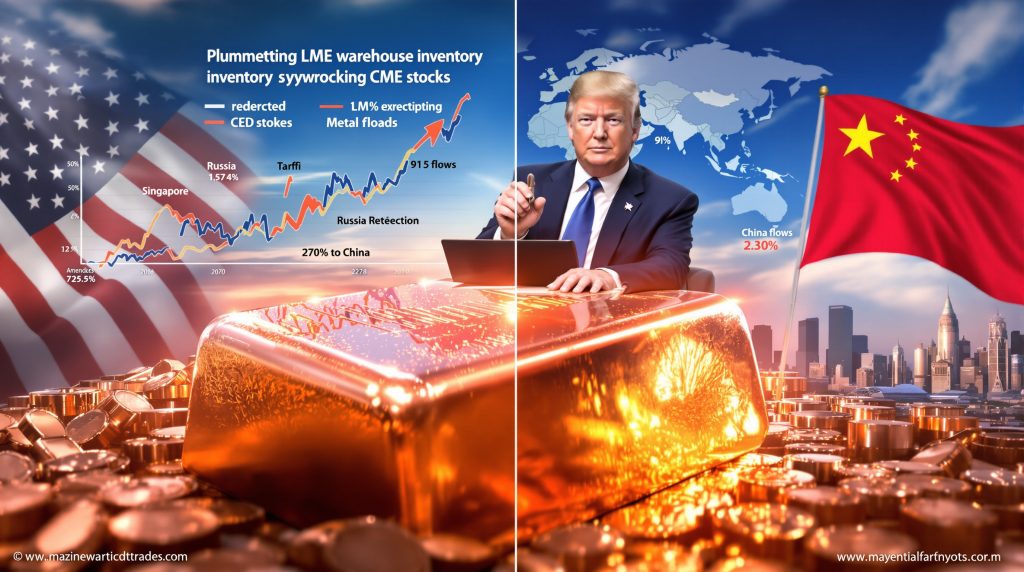Understanding the Trump Administration's Section 232 Investigation
The February 2025 announcement of a national security investigation into U.S. copper imports sent shockwaves through global metal markets. President Trump's executive order directed the Department of Commerce to examine whether copper imports threatened American national security under Section 232 of the Trade Expansion Act of 1962. This investigation represented a significant escalation in trade policy, extending beyond previous Section 232 actions on steel and aluminum to encompass a metal critical for electrification, renewable energy, and defense applications.
The investigation's scope was comprehensive, covering raw copper, concentrates, refined products, alloys, and scrap. The Commerce Department was tasked with evaluating domestic production capacity, foreign dependency risks, and the strategic importance of copper to national defense and critical infrastructure. This broad mandate signaled the administration's intention to potentially implement substantial tariff effects on markets and trade restrictions on a commodity fundamental to modern manufacturing and energy systems.
Key Concerns Driving the Investigation
Several factors motivated the investigation into copper imports:
-
Defense Applications: Copper is essential for military hardware, communications systems, and electronics, making it strategically vital for national security
-
Energy Transition Dependencies: The growing demand for copper in renewable energy, electric vehicles, and grid infrastructure created concerns about supply security
-
Chinese Processing Dominance: While China produces only about 10% of global copper, it controls 65-90% of global processing capacity
-
Domestic Production Decline: U.S. reliance on imports has grown as domestic production capacity has diminished over decades
-
Supply Chain Vulnerabilities: Concentrated production in politically unstable regions creates exposure to disruptions
The investigation reflected growing recognition that economic security and national security are increasingly intertwined, particularly for materials essential to both defense systems and clean energy transition.
The Market's Immediate Response: The Tariff Arbitrage Trade
When Trump announced the copper imports national security investigation in February 2025, it triggered one of the most significant arbitrage opportunities in recent commodity market history. Traders quickly recognized the potential for substantial price differentials between international copper prices on the London Metal Exchange (LME) and U.S. domestic prices on the CME if tariffs were implemented.
The Unprecedented Inventory Shift
The market response was dramatic and immediate:
-
LME warehouses experienced a massive drawdown as traders shipped copper to the United States
-
U.S. imports of refined copper surged to 724,000 tons between March and June 2025, equivalent to 80% of the country's entire 2024 import demand
-
CME registered copper stocks skyrocketed to a 21-year high of 247,210 tons
-
LME inventory fell by 43% from January 2025 levels despite some replenishment from Chinese smelters
This inventory movement represented a purely speculative positioning rather than a fundamental shift in demand. Traders anticipated that if tariffs were implemented, copper already in the U.S. would avoid the duties and command premium prices in the domestic market.
Price Impacts and Market Distortions
The arbitrage trade created significant price distortions:
-
The premium for U.S. copper over LME prices widened to historic levels
-
Price volatility increased substantially as traders positioned for potential tariff announcements
-
Physical delivery premiums in U.S. ports rose sharply
-
The futures curve structure shifted dramatically as near-term contracts reflected immediate inventory tightness
These market distortions highlighted how trade policy uncertainty can create significant inefficiencies in global commodity markets, with costs ultimately passed to consumers and manufacturing industries.
Presidential Proclamation and Tariff Implementation
On July 30, 2025, President Trump signed Proclamation 10962, implementing substantial tariffs on copper imports based on the Commerce Department's findings that imports threatened national security. The proclamation exceeded the Department's initial recommendations, demonstrating the administration's aggressive stance on trade protection.
Tariff Structure and Timeline
The implemented tariffs were structured in phases:
-
50% tariff on semi-finished copper products and intensive copper derivative products effective August 1, 2025
-
15% tariff on refined copper beginning in 2027, increasing to 30% in 2028
-
Country exemptions for Canada and Mexico under USMCA provisions
-
Product-specific exclusion process for items without sufficient domestic alternatives
This phased approach aimed to provide time for domestic supply chains to adjust while immediately protecting downstream manufacturing capabilities deemed most critical for national security applications.
Additional Policy Measures
Beyond tariffs, the proclamation implemented unprecedented measures:
-
Domestic sales requirements under Defense Production Act authorities, mandating that 25% of copper input materials and high-quality scrap be sold to domestic purchasers starting in 2027
-
Export controls on high-quality copper scrap to preserve feedstock for American producers
-
Addition of copper to high-priority sectors under the Uyghur Forced Labor Prevention Act, increasing scrutiny on imports potentially linked to forced labor
These complementary policies represented a comprehensive approach to securing copper supply chains through multiple regulatory frameworks, moving beyond traditional trade remedies to active industrial policy interventions.
The Tariff Trade Implosion
When the Commerce Department's investigation concluded without recommending immediate tariffs on refined copper (instead proposing a phased approach beginning in 2027), the massive arbitrage trade that had developed collapsed spectacularly.
Market Reversal and Financial Fallout
The trade unwinding created significant market turbulence:
-
CME copper prices plummeted as traders rushed to liquidate positions
-
The premium between U.S. and international prices narrowed dramatically
-
Physical delivery premiums in U.S. ports fell sharply
-
Trading firms that had accumulated large physical positions faced substantial losses
-
Warehousing companies that had expanded capacity for the anticipated storage boom saw utilization rates collapse
This market reversal demonstrated the risks of positioning based on anticipated policy outcomes, particularly when those policies involve complex national security considerations rather than purely economic factors.
Lessons from the Failed Arbitrage
The collapse of the copper tariffs and prices trade offered several lessons for commodity markets:
-
Policy uncertainty creates both opportunities and substantial risks
-
Physical commodity positioning involves significant carrying costs that can erode profits if timing is miscalculated
-
National security-based trade actions may follow different timelines and considerations than traditional trade remedies
-
Market consensus can be dramatically wrong about policy outcomes
-
The costs of failed arbitrage trades are ultimately borne by consumers through price volatility and market inefficiency
These lessons may influence how traders approach future trade policy-driven opportunities, potentially reducing the magnitude of speculative positioning in response to similar announcements.
LME Warehouse Capacity Reduction: A Structural Shift
One of the most significant long-term impacts of the copper investigation has been the structural reduction in London Metal Exchange warehouse capacity. Total registered storage space fell to 3.2 million square meters by June 2025, a 4.25% decline in just six months despite the opening of new delivery locations in Hong Kong and Jeddah.
Factors Driving Warehouse Contraction
Several factors contributed to this contraction:
-
Declining exchange inventory levels made warehouse operations less profitable
-
Geopolitical fragmentation of metal flows reduced the centrality of traditional trading hubs
-
Sanctions and tariffs redirected metal to alternative markets and storage locations
-
Rising costs for warehouse operations in traditional locations pressured margins
-
Uncertainty about future metal flows discouraged capacity investments
This warehouse capacity reduction represents a fundamental shift in physical market infrastructure rather than a cyclical change, potentially limiting the exchange's ability to function as a market of last resort during future supply disruptions.
Regional Impacts on Storage Infrastructure
The warehouse capacity changes varied significantly by region:
-
Port Klang in Malaysia saw capacity decline by 15% in six months as ISTIM UK Ltd reduced its presence from 22 to 13 units
-
Singapore increased its warehouse count by nine units to 38, reflecting its growing importance for zinc and lead storage
-
New locations in Hong Kong (8 units) and Jeddah (4 units) partially offset declines elsewhere
-
European locations continued their long-term decline as metal flows shifted eastward
These regional shifts reflect the growing fragmentation of global metal markets along geopolitical lines, with warehousing infrastructure increasingly aligned with new trade patterns shaped by sanctions, tariffs, and strategic considerations.
China's Strategic Response and Market Redirection
China's response to the U.S. copper investigation and subsequent tariffs has accelerated the redirection of global metal flows, particularly for Russian-origin material facing Western restrictions.
Increased China-Russia Metal Trade
The redirection of Russian metal to China has been dramatic:
-
Chinese imports of Russian aluminum surged 80% year-on-year to 1.1 million tons in January-June 2025
-
Russian copper increasingly flows to Chinese markets as Western buyers avoid material due to sanctions concerns
-
Chinese smelters have increased processing of Russian copper concentrates
-
Payment mechanisms have evolved to facilitate trade outside Western financial systems
This growing trade relationship may prove difficult to reverse even if Western sanctions are eventually lifted, representing a potentially permanent restructuring of global metal flows.
Strategic Stockpiling and Processing Capacity
China has responded to Western supply chain initiatives with its own strategic actions:
-
Accelerated development of domestic copper processing capacity
-
Strategic stockpiling of critical metals including copper
-
Investments in overseas mining assets to secure primary supply
-
Development of alternative trading platforms and pricing mechanisms less dependent on Western exchanges
-
Expansion of warehousing infrastructure to accommodate redirected metal flows
These actions reflect China's long-term strategy to reduce vulnerability to Western trade actions while strengthening its position in global metal supply chains.
Impact on Global Copper Stocks Distribution
The combined effects of the U.S. investigation, tariff speculation, and China's strategic response have dramatically altered the global distribution of copper inventories.
Exchange Inventory Shifts
The redistribution of exchange inventories has been substantial:
-
LME copper stocks fell by 43% from January 2025 levels despite some replenishment
-
CME stocks reached a 21-year high of 247,210 tons
-
Shanghai Futures Exchange inventories increased as more material flowed to Chinese markets
-
Total global exchange stocks remained relatively stable, but their distribution shifted dramatically
This redistribution reflects both speculative positioning and fundamental changes in trade flows resulting from policy actions and geopolitical considerations.
Off-Warrant and Strategic Stockpiles
Beyond visible exchange inventories, significant shifts occurred in less transparent storage:
-
Private bonded warehouses in China saw increased inflows
-
Strategic stockpiles in multiple countries grew as governments prioritized supply security
-
Off-warrant LME stocks declined as material moved to other locations
-
Producer and consumer inventories increased as supply chain participants sought buffer stocks against future disruptions
These less visible inventory shifts may have greater long-term significance than the more publicized exchange stock movements, potentially creating hidden buffers or vulnerabilities in global supply chains.
How Are Zinc and Lead Markets Affected?
While the copper investigation directly targeted only copper imports, its effects have spilled over into other base metal markets, particularly zinc and lead, which share warehousing infrastructure and trading patterns with copper.
Singapore's Emerging Role in Zinc and Lead Storage
Singapore has emerged as a focal point for LME zinc and lead storage:
-
The city now accounts for 99% of registered LME zinc inventory and 97% of lead inventory
-
Warehouse operators have opened more units in Singapore than anywhere else over the past 12 months
-
The number of listed warehouses increased by nine to 38, outpacing new locations in Hong Kong and Jeddah
-
Recent zinc stock drawdowns have created market uncertainty despite relatively relaxed time spreads
This concentration creates both opportunities and risks, potentially making Singapore a critical chokepoint in global zinc and lead supply chains.
Market Signals and Price Relationships
The investigation's spillover effects on market signals have been significant:
-
Zinc time spreads remain in contango despite low visible inventory, suggesting substantial off-market stocks
-
Lead's persistent stock churn in Singapore indicates active financing deals rather than fundamental demand
-
Correlation between copper and zinc prices increased during periods of tariff speculation
-
Regional premiums for zinc and lead followed copper patterns in anticipation of broader metal tariffs
These market signals suggest traders are positioning for potential expansion of national security-based trade restrictions to other base metals, creating preemptive shifts in inventory and trade flows.
Long-Term Implications for Global Metal Markets
The copper imports national security investigation and subsequent policy actions represent more than a temporary disruption—they signal a fundamental shift in how governments approach strategic metals and global supply chains.
Fragmentation of Global Metal Markets
The investigation has accelerated the fragmentation of once-globalized metal markets:
-
Growing divergence between Western and Chinese metal pricing and physical flows
-
Reduced fungibility of metal based on origin as sanctions and tariffs create segmented markets
-
Development of parallel trading and warehousing systems aligned with geopolitical blocs
-
Increased regionalization of supply chains to reduce cross-border vulnerabilities
This fragmentation reduces market efficiency while increasing costs and complexity for global manufacturers and consumers.
Rising Strategic Premium in Metal Pricing
A new "strategic premium" is emerging in metal pricing:
-
Materials with secure supply chains command higher prices regardless of physical characteristics
-
Origin-specific pricing differentials based on geopolitical rather than quality considerations
-
Increased volatility as policy announcements create rapid shifts in perceived supply security
-
Growing importance of long-term contracts with supply security provisions rather than spot market transactions
This strategic premium represents an additional cost layer in global supply chains, ultimately affecting downstream industries and consumers.
Implications for Exchange-Based Price Discovery
Traditional exchange-based price discovery mechanisms face growing challenges:
-
Reduced relevance of benchmark prices as markets fragment along geopolitical lines
-
Declining warehouse networks limit exchanges' ability to function as markets of last resort
-
Growing importance of regional premiums relative to global benchmark prices
-
Potential development of alternative pricing mechanisms less vulnerable to policy-driven distortions
These challenges may fundamentally alter how metals are priced and traded globally, potentially reducing transparency and increasing transaction costs.
What Does This Mean for Mining Investment?
The national security focus on copper has significant implications for mining investment decisions and project development timelines.
Reassessment of Project Risk Profiles
Mining companies are reassessing project risk profiles:
-
Projects in politically aligned countries receive higher valuations despite potentially higher operating costs
-
Development timelines for domestic projects are being accelerated through permitting reforms and financial incentives
-
Investments in processing capabilities receive increased attention relative to mining operations
-
Diversification of asset portfolios across political boundaries to hedge against geopolitical risks
These shifts may fundamentally alter the global landscape of mining investment, potentially reversing decades of focus on lowest-cost production regardless of location.
Government Support and Strategic Partnerships
Government involvement in mining investment is increasing:
-
Direct financial support for projects deemed strategically important
-
Public-private partnerships to accelerate development timelines
-
Loan guarantees and tax incentives targeted at domestic production
-
Strategic minerals lists expanding to include more metals and materials
-
Coordination between allied countries on investment priorities and supply chain development
This increased government role represents a significant shift from market-driven investment decisions toward more strategically directed capital allocation.
Conclusion: A New Era of Strategic Metal Markets
The copper imports national security investigation marks a pivotal moment in the evolution of global metal markets. What began as a trade policy action has catalyzed fundamental changes in how governments, companies, and traders approach strategic metals. The investigation's impacts extend far beyond copper, affecting warehouse networks, trading patterns, investment decisions, and market structures across the metals complex.
As global metal markets continue to adapt to this new reality, several trends appear likely to persist:
-
Growing fragmentation along geopolitical lines
-
Increased government involvement in supply chain development
-
Rising strategic premiums for secure supply
-
Challenges to traditional price discovery mechanisms
-
Realignment of physical infrastructure to match new trade patterns
These changes signal the emergence of a new era in which metal markets are shaped as much by strategic considerations as by traditional supply-demand fundamentals. For market participants, policymakers, and consumers, navigating this new landscape will require fresh approaches that account for both economic and geopolitical factors in decision-making.
Understanding Trump's copper tariffs impact and implementing effective copper investment strategies has become increasingly important in this changing landscape. Furthermore, investors should carefully consider copper price insights to navigate these complex market conditions.
Further Exploration
Readers interested in learning more about the impacts of trade policy on global metal markets can also explore related educational content, such as MINING.com's article "Column: LME storage capacity falls as politics upend metal flows" which offers additional perspectives on how geopolitical factors are reshaping metal trading infrastructure.
Looking for the Next Major Mineral Discovery?
Stay ahead of the market with Discovery Alert's proprietary Discovery IQ model, which instantly identifies significant ASX mineral discoveries and transforms complex data into actionable investment insights. Explore our dedicated discoveries page to understand how historic mineral discoveries have generated substantial returns for early investors.




